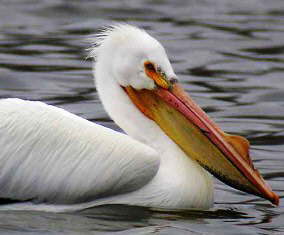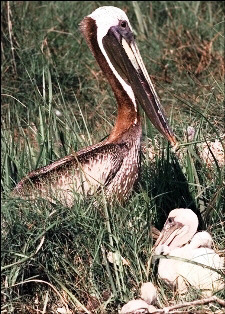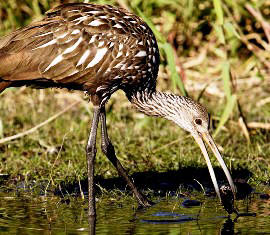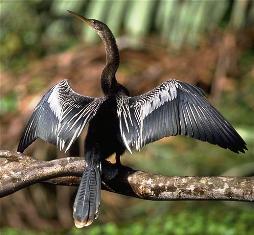Discover Florida Nature
It's time to explore the natural Florida


|
|
|
|
|
 American
White Pelican- With a wingspan as great as nine and a half
feet, the American white pelican is one of North America's largest
birds. Unlike the brown pelican, which is found year-round in Florida,
and non-breeding white pelican juveniles, healthy adult white pelicans
are winter visitors to the state. In the summer, white pelican adults
breed in colonies on lakes in the interior of western Canada and the
northwestern United States. Winters are spent in southern Mexico,
southern California and along the Gulf Coast states of Texas, Louisiana,
Mississippi and Florida. White pelicans feed differently than brown
pelicans. They do not plunge dive as brown pelicans do, instead white
pelicans float on the surface, submerge their heads and scoop up fish.
They also often fish cooperatively in small groups, herding the fish in
front of them. In flight, white pelicans have a graceful strong flight
and usually fly in large flocks high in the air and in a V formation.
Adults are a distinctive white with black wing tips. The bill, legs and
toes are reddish-orange or pink. American
White Pelican- With a wingspan as great as nine and a half
feet, the American white pelican is one of North America's largest
birds. Unlike the brown pelican, which is found year-round in Florida,
and non-breeding white pelican juveniles, healthy adult white pelicans
are winter visitors to the state. In the summer, white pelican adults
breed in colonies on lakes in the interior of western Canada and the
northwestern United States. Winters are spent in southern Mexico,
southern California and along the Gulf Coast states of Texas, Louisiana,
Mississippi and Florida. White pelicans feed differently than brown
pelicans. They do not plunge dive as brown pelicans do, instead white
pelicans float on the surface, submerge their heads and scoop up fish.
They also often fish cooperatively in small groups, herding the fish in
front of them. In flight, white pelicans have a graceful strong flight
and usually fly in large flocks high in the air and in a V formation.
Adults are a distinctive white with black wing tips. The bill, legs and
toes are reddish-orange or pink. Brown
Pelican- Brown pelicans are large, shore-dwelling birds. They
reach sizes up to 48 inches long from head to tail, with a 6-7 foot
wingspan and a weight of about 8 pounds. They are strong swimmers and
graceful flyers, but are rather clumsy when walking on land. They are
long-lived, the oldest individual on record died at 43 years of age.
They can be observed along the coasts from North to South America.
Pelicans are fish eating birds. They have excellent eyesight and hunt
by searching for schools of small bait fish while flying over the ocean,
sometimes from as high as 50 feet. When pelicans see fish they will
dive steeply into the water, often submerging completely, and capture
the fish in their large throat pouches. Brown Pelicans are the only
pelican bird to use this dramatic hunting style. Like many birds, newly
hatched pelicans are featherless and completely dependent upon their
parents. Each young pelican usually requires about 50 pounds of food
and about 75 days to reach the point of fledging, or first flight. Brown
Pelican- Brown pelicans are large, shore-dwelling birds. They
reach sizes up to 48 inches long from head to tail, with a 6-7 foot
wingspan and a weight of about 8 pounds. They are strong swimmers and
graceful flyers, but are rather clumsy when walking on land. They are
long-lived, the oldest individual on record died at 43 years of age.
They can be observed along the coasts from North to South America.
Pelicans are fish eating birds. They have excellent eyesight and hunt
by searching for schools of small bait fish while flying over the ocean,
sometimes from as high as 50 feet. When pelicans see fish they will
dive steeply into the water, often submerging completely, and capture
the fish in their large throat pouches. Brown Pelicans are the only
pelican bird to use this dramatic hunting style. Like many birds, newly
hatched pelicans are featherless and completely dependent upon their
parents. Each young pelican usually requires about 50 pounds of food
and about 75 days to reach the point of fledging, or first flight. Limpkin-
In the United States, limpkins are found in southern Georgia and Florida
in the shallows along rivers, streams and lakes, and in marshes, swamps
and sloughs. Along spring runs and rivers, you may notice small clusters
of pink-tinted eggs attached to plants and roots at the water's edge.
These are the eggs of the apple snail, chief food of the limpkin, a
long-legged waterbird with a downcurved bill. The limpkin resembles a
rail but stands taller, has a longer neck and is distinguished by its
dark brown feathers flecked with white, which give it a spotted
appearance. It is probably better known for its voice, described as a
piercing repeated wail, "Kree-ow, Kra-ow," often heard in the background
of old Tarzan movies. The sound of several males calling is described as
"one of the weirdest cacophonies of nature." As the limpkin walks
through shallow water, it uses sight and touch to search for apple
snails, mussels, worms and insects. The sharp and twisted end of its
curved bill fits perfectly into a snail shell, allowing the limping to
deftly extract the mollusk. Limpkin-
In the United States, limpkins are found in southern Georgia and Florida
in the shallows along rivers, streams and lakes, and in marshes, swamps
and sloughs. Along spring runs and rivers, you may notice small clusters
of pink-tinted eggs attached to plants and roots at the water's edge.
These are the eggs of the apple snail, chief food of the limpkin, a
long-legged waterbird with a downcurved bill. The limpkin resembles a
rail but stands taller, has a longer neck and is distinguished by its
dark brown feathers flecked with white, which give it a spotted
appearance. It is probably better known for its voice, described as a
piercing repeated wail, "Kree-ow, Kra-ow," often heard in the background
of old Tarzan movies. The sound of several males calling is described as
"one of the weirdest cacophonies of nature." As the limpkin walks
through shallow water, it uses sight and touch to search for apple
snails, mussels, worms and insects. The sharp and twisted end of its
curved bill fits perfectly into a snail shell, allowing the limping to
deftly extract the mollusk. Anhinga-
The anhinga is a water bird. It does not have oil glands for
waterproofing its feathers like most water birds. When it goes swimming
its feathers get wet. This helps it dive and chase fish underwater.
However when it is above water, it must spread its wings to dry in the
sun. It can fly with wet feathers but not as well. The adults have
beautiful white feathers. The long tail has given the anhinga the
nickname, "water turkey". It is also known as the snake-bird because of
its snake-like neck. The female anhinga is easy to spot. Her neck and
chest feathers are much lighter in color than the male. The anhinga
spears his prey with his pointed beak like an arrow. Sometimes the
anhinga's thrust is so powerful that the anhinga has to swim to shore
and pry the fish off his beak by rubbing it against a rock. The Anhinga
is frequently seen soaring high in the sky overhead. It is a graceful
flier and can travel long distances without flapping its wings, much in
the manner of a Turkey Vulture Anhinga-
The anhinga is a water bird. It does not have oil glands for
waterproofing its feathers like most water birds. When it goes swimming
its feathers get wet. This helps it dive and chase fish underwater.
However when it is above water, it must spread its wings to dry in the
sun. It can fly with wet feathers but not as well. The adults have
beautiful white feathers. The long tail has given the anhinga the
nickname, "water turkey". It is also known as the snake-bird because of
its snake-like neck. The female anhinga is easy to spot. Her neck and
chest feathers are much lighter in color than the male. The anhinga
spears his prey with his pointed beak like an arrow. Sometimes the
anhinga's thrust is so powerful that the anhinga has to swim to shore
and pry the fish off his beak by rubbing it against a rock. The Anhinga
is frequently seen soaring high in the sky overhead. It is a graceful
flier and can travel long distances without flapping its wings, much in
the manner of a Turkey Vulture |
|
|
Advertise | Privacy Statement | Dog Encyclopedia | Video |Contact | Alaska Nature |
|